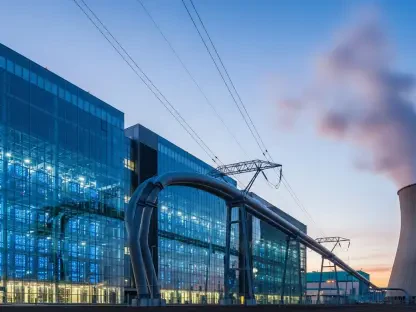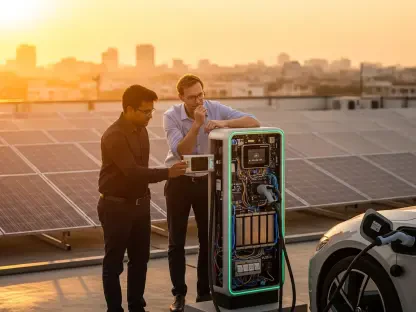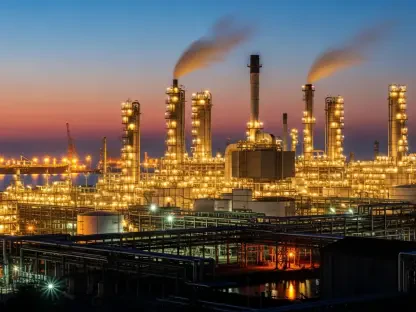In an era where sustainability is no longer just a buzzword but a critical necessity, the commercial heating industry is witnessing a profound transformation with gas-fired condensing boilers leading the charge. These advanced systems, engineered to operate at lower temperatures while achieving remarkable energy efficiency, are revolutionizing heating solutions across offices, hotels, hospitals, and educational facilities. By harnessing condensation technology to recover heat from exhaust gases, they drastically reduce fuel consumption and minimize greenhouse gas emissions. As global pressures mount for businesses and governments to adopt greener practices, these boilers stand out as a pivotal innovation. Their ability to deliver high performance with a smaller environmental footprint positions them as a cornerstone in the quest for sustainable heating. This discussion explores the market dynamics, key drivers, and regional trends that underscore their growing importance, shedding light on how they are poised to redefine the future of commercial heating systems worldwide.
Driving Forces Behind the Market Surge
The market for gas-fired condensing low-temperature commercial boilers is experiencing a remarkable upswing, with projections indicating a rise from USD 178.8 million in 2025 to an impressive USD 389.6 million by 2035, reflecting a robust annual growth rate of 8.1%. This expansion is fueled by an escalating demand for energy-efficient heating systems amid tightening environmental regulations across the globe. Regions like North America, Europe, and parts of Asia-Pacific are seeing early and significant adoption, driven by policies that prioritize sustainability. The versatility of these boilers makes them suitable for a wide array of commercial spaces, from corporate offices to large institutional buildings. As awareness spreads about their long-term cost savings and environmental benefits, their penetration into diverse markets is expected to deepen, signaling a shift toward smarter, greener heating solutions that align with global energy goals.
Several compelling factors are accelerating the adoption of these innovative boilers in the commercial sector. Government policies and incentives aimed at reducing carbon footprints play a central role, encouraging facility managers to transition from outdated, inefficient heating systems to high-efficiency alternatives. Rising energy costs further amplify this trend, as businesses seek technologies that lower fuel expenses without compromising performance. Beyond economics, the push for modernization in aging infrastructure is creating a steady demand for replacements, particularly in regions with older building stock. Manufacturers are also contributing by forging strategic partnerships with energy management firms, enhancing access to these systems. This confluence of regulatory support, financial incentives, and industry collaboration is paving the way for gas-fired condensing boilers to become a standard in commercial heating, reshaping energy consumption patterns for the better.
Technological and Segmental Advantages
One of the standout features of gas-fired condensing boilers is their performance in low-temperature settings, particularly those operating at or below 120°F, which are projected to command over 37% of market revenue in 2025. These systems excel in applications like underfloor heating and fan coil units, where lower return water temperatures maximize heat recovery from exhaust gases. Such efficiency aligns seamlessly with stringent regulatory standards that demand reduced flow temperatures, ensuring exceptional seasonal performance. This capability not only cuts energy use but also positions these boilers as a preferred choice for commercial environments aiming to meet sustainability targets. Their design prioritizes optimal heat transfer, making them indispensable in modern heating setups that require both precision and environmental responsibility, thus setting a new benchmark for efficiency in the industry.
When examining capacity, boilers ranging from 0.3 to 2.5 MMBTU/hr dominate the market, holding a substantial 41.8% share in 2025. Tailored for small to medium-sized commercial spaces such as retail outlets, schools, and offices, these units offer remarkable flexibility through modular and scalable designs. This adaptability allows for customized heating solutions, whether in new constructions or retrofit projects, addressing varying demands with ease. Facility managers value this balance of cost-effectiveness and efficiency, as it enables them to optimize energy use without overspending on oversized systems. The popularity of this capacity range reflects a broader trend toward practical, user-friendly technologies that cater to the specific needs of diverse commercial environments, reinforcing the role of condensing boilers in delivering sustainable heating solutions that are both accessible and impactful.
Sector-Specific Adoption Trends
The office sector is at the forefront of embracing gas-fired condensing boilers, accounting for nearly 29% of market revenue in 2025. This significant uptake is driven by a strategic focus on slashing operational costs while maintaining comfortable indoor environments for employees and clients. Advanced control systems and zoning capabilities integrated into these boilers allow for precise temperature management, ensuring energy is used only where and when needed. Such features resonate with the broader push in commercial real estate to invest in infrastructure that yields long-term savings and supports environmental goals. As office buildings increasingly prioritize energy management, these boilers emerge as a critical tool, enabling property owners to reduce their carbon footprint while enhancing occupant satisfaction through reliable, efficient heating.
Beyond offices, the appeal of these systems extends to other commercial sectors like hospitality, healthcare, and education, each benefiting from tailored applications. In hotels and hospitals, where consistent hot water and space heating are non-negotiable, condensing boilers provide a reliable solution that curbs energy waste. Educational institutions, often operating on tight budgets, find the cost savings and efficiency of these systems particularly attractive for maintaining large campus facilities. The ability to integrate with smart building technologies further amplifies their value, allowing for real-time monitoring and adjustments that optimize performance. This cross-sector adoption highlights the versatility of gas-fired condensing boilers, positioning them as a universal answer to the heating challenges faced by modern commercial entities striving for sustainability and fiscal responsibility.
Regional Dynamics Fueling Growth
Globally, the growth of gas-fired condensing boilers varies significantly across regions, reflecting diverse economic and policy landscapes. China leads with a projected growth rate of 10.9%, propelled by rapid commercial construction and strong government initiatives promoting energy-efficient technologies. Local manufacturers are rising to the challenge, producing advanced systems with features like digital monitoring and heat recovery to meet international standards. Similarly, India shows robust growth at 10.1%, driven by expanding sectors such as hospitality and healthcare, alongside supportive policies for carbon reduction. These emerging markets illustrate how industrialization and regulatory frameworks can accelerate the adoption of sustainable heating technologies, setting a precedent for other developing regions to follow in prioritizing efficiency and environmental stewardship.
In more mature markets, Europe and North America showcase distinct yet equally impactful trends. Germany, with a growth rate of 9.3%, benefits from stringent environmental laws and a focus on retrofitting outdated heating systems with modular, high-efficiency units. The United Kingdom follows at 7.7%, supported by energy standards and modernization efforts in institutional buildings, while the United States grows at 6.9%, fueled by retrofit initiatives and expanding commercial infrastructure. These regions underscore the importance of regulatory compliance and government incentives in driving market expansion. The integration of condensing boilers with building automation systems in these areas enhances operational efficiency, demonstrating how tailored solutions and policy support can transform heating practices in established economies, paving the way for broader global adoption.
Emerging Trends and Industry Outlook
A clear consensus exists across the industry on the paramount importance of energy efficiency and emissions reduction, shaping the trajectory of gas-fired condensing boilers. Industrial facilities are increasingly turning to these systems for precise process heating and hot water generation, valuing both cost savings and environmental benefits. Public sector procurement policies also favor high-efficiency, low-emission technologies, boosting adoption in government buildings and institutions. This widespread shift reflects a growing recognition that sustainable heating solutions are not just an option but a necessity for meeting global climate targets. As commercial and industrial sectors align with these priorities, condensing boilers are becoming integral to infrastructure projects, highlighting their role in fostering a greener, more responsible approach to energy consumption.
Technological innovation continues to define the competitive landscape, with manufacturers focusing on enhanced heat exchanger designs, digital controls, and compact configurations to improve reliability and performance. These advancements allow companies to differentiate their offerings in a crowded market, catering to diverse needs with scalable solutions and smart monitoring capabilities. The rivalry among established players and regional manufacturers drives continuous improvement, ensuring that end-users benefit from cutting-edge systems that deliver both efficiency and durability. As the market evolves, this emphasis on innovation and accessibility is expected to sustain growth, positioning gas-fired condensing boilers as a cornerstone of future heating strategies that balance economic and environmental imperatives with unmatched precision.
Reflecting on a Sustainable Path Forward
Looking back, the journey of gas-fired condensing boilers reveals a compelling narrative of adaptation and progress within the commercial heating sector. Their rise is marked by a harmonious blend of regulatory encouragement, technological breakthroughs, and economic incentives that collectively transformed how commercial spaces approach energy use. The significant market growth, diverse regional adoption, and sector-specific applications illustrate a shared commitment to sustainability that transcends borders and industries. Moving forward, the focus should shift toward accelerating innovation in smart integration and modular designs to address emerging needs. Stakeholders must also prioritize expanding access through strategic partnerships and policy advocacy to ensure that even smaller markets can embrace these solutions. By building on past achievements, the industry can continue to refine and promote these boilers as a vital tool in achieving a more energy-efficient and environmentally conscious future for commercial heating worldwide.









